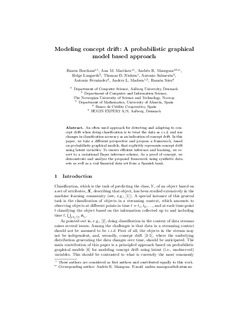| dc.contributor.author | Borchani, Hanen | |
| dc.contributor.author | Martinez, Ana M. | |
| dc.contributor.author | Masegosa, Andres | |
| dc.contributor.author | Langseth, Helge | |
| dc.contributor.author | Nielsen, Thomas D. | |
| dc.contributor.author | Salmeron, Antonio | |
| dc.contributor.author | Fernandez, Antonio | |
| dc.contributor.author | Madsen, Anders L. | |
| dc.contributor.author | Sáez, Ramón | |
| dc.date.accessioned | 2015-11-03T10:06:49Z | |
| dc.date.accessioned | 2016-05-12T07:22:30Z | |
| dc.date.available | 2015-11-03T10:06:49Z | |
| dc.date.available | 2016-05-12T07:22:30Z | |
| dc.date.issued | 2015-11-22 | |
| dc.identifier.citation | Lecture Notes in Computer Science 2015, 9385:72-83 | nb_NO |
| dc.identifier.issn | 1611-3349 | |
| dc.identifier.uri | http://hdl.handle.net/11250/2389143 | |
| dc.description.abstract | An often used approach for detecting and adapting to concept
drift when doing classification is to treat the data as i.i.d. and use
changes in classification accuracy as an indication of concept drift. In this
paper, we take a different perspective and propose a framework, based
on probabilistic graphical models, that explicitly represents concept drift
using latent variables. To ensure efficient inference and learning, we resort
to a variational Bayes inference scheme. As a proof of concept, we demonstrate
and analyze the proposed framework using synthetic data sets as
well as a real financial data set from a Spanish bank. | nb_NO |
| dc.language.iso | eng | nb_NO |
| dc.publisher | Spriner Verlag | nb_NO |
| dc.title | Modeling concept drift: A probabilistic graphical model based approach | nb_NO |
| dc.type | Journal article | nb_NO |
| dc.type | Peer reviewed | nb_NO |
| dc.date.updated | 2015-11-03T10:06:49Z | |
| dc.source.pagenumber | 72-83 | nb_NO |
| dc.source.volume | 9385 | nb_NO |
| dc.source.journal | Lecture Notes in Computer Science | nb_NO |
| dc.identifier.doi | 10.1007/978-3-319-24465-5_7 | |
| dc.identifier.cristin | 1285789 | |
| dc.description.localcode | © Springer. This is the authors’ accepted and refereed manuscript to the article. | nb_NO |
